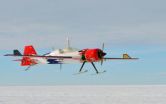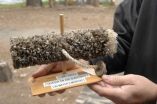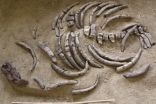(Press-News.org) Scientists studying the behavior of the world's ice sheets--and the future implications of ice sheet behavior for global sea-level rise--may soon have a new airborne tool that will allow radar measurements that previously would have been prohibitively expensive or difficult to carry out with manned aircraft.
In a paper published in the March/ April edition of IEEE Geoscience and Remote Sensing Magazine, researchers at the Center for Remote Sensing of Ice Sheets (CReSIS) at the University of Kansas noted that they have successfully tested the use of a compact radar system integrated on a small, lightweight Unmanned Aircraft System (UAS) to look through the ice and map the topography underlying rapidly moving glaciers.
"We're excited by the performance we saw from our radar and UAS during the field campaign. The results of this effort are significant, in that the miniaturized radar integrated into a UAS promises to make this technology more broadly accessible to the research community," said Rick Hale, associate professor of aerospace engineering and associate director of technology for CReSIS.
With support from the National Science Foundation's Division of Polar Programs and the State of Kansas, the CReSIS team recently successfully tested the UAS at a field camp in West Antarctica.
The measurements were the first-ever successful sounding of glacial ice with a UAS-based radar. If further tests in the Arctic prove as successful, the UAS could eventually be routinely deployed to measure rapidly changing areas of the Greenland and Antarctic ice sheets.
The use of unmanned aircraft in Antarctica, which is becoming a subject of wide international interest, is scheduled to be discussed in May at the upcoming Antarctic Treaty Consultative Meeting in Brazil.
The small but agile UAS has a takeoff weight of about 38.5 kilograms (85 pounds) and a range of approximately 100 kilometers (62 miles). The compact radar system weighs only two kilograms, and the antenna is structurally integrated into the wing of the aircraft.
The radar-equipped UAS appears to be an ideal tool for reaching areas that otherwise would be exceptionally difficult to map. The light weight and small size of the vehicle and sensor enable them to be readily transported to remote field locations, and the airborne maneuverability enables the tight flight patterns required for fine scale imaging. The UAS can be used to collect data over flight tracks about five meters apart to allow for more thorough coverage of a given area.
According to Shawn Keshmiri, an assistant professor of aerospace engineering, "a small UAS also uses several orders of magnitude less fuel per hour than the traditional manned aircraft used today for ice sounding."
This advantage is of great benefit, the researchers point out, "in remote locations, such as Antarctica, [where] the cost associated with transporting and caching fuel is very high."
The vast polar ice sheets hold an enormous amount of the Earth's freshwater--so much so that in the unlikely event of a sudden melt, global sea level would rise on the order of 66 meters (216 feet).
Even a fraction of the melt, and the associated sea-level, rise would cause severe problems to people living in more temperate areas of the globe, so scientists and engineers are seeking quicker, less expensive ways to measure and eventually predict exactly what it is that the ice sheets are doing and how their behavior may change in the future.
Until now, the lack of fine-resolution information about the topography underlying fast-flowing glaciers, which contain huge amounts of freshwater and which govern the flow of the interior ice, makes it difficult to model their behavior accurately.
"There is therefore an urgent need to measure the ice thickness of fast-flowing glaciers with fine resolution to determine bed topography and basal conditions," the researchers write. "This information will, in turn, be used to improve ice-sheet models and generate accurate estimates of sea level rise in a warming climate. Without proper representation of these fast-flowing glaciers, advancements in ice-sheet modeling will remain elusive."
With the successful test completed in the Antarctic, the researchers will begin analyzing the data collected during this field season, miniaturizing the radar further and reducing its weight to 1.5 kilograms (3.3 pounds) or less, and increasing the UAS radar transmitting power.
In the coming months, they will also perform additional test flights in Kansas to further evaluate the avionics and flight-control systems, as well as optimize the radar and transmitting systems.
In 2014 or 2015, they plan to deploy the UAS to Greenland to collect data over areas with extremely rough surfaces and fast-flowing glaciers, such as Jakobshavn, which is among the fastest flowing glaciers in the world.
INFORMATION:
-NSF-
Remotely operated aircraft successfully tested as tool for measuring changes in polar ice sheets
Boldly going where larger, human-piloted planes cannot, they promise to close a key gap in knowledge for climate modelers
2014-04-02
ELSE PRESS RELEASES FROM THIS DATE:
Don't move a mussel (or a clam, or a snail)
2014-04-02
(Millbrook, NY) Anyone that has spent time at a seaside pier has witnessed the destruction barnacles wreak on boat hulls. But biofouling animals are not limited to marine environments. A new paper published in the journal Frontiers in Ecology and the Environment estimates that the global management of freshwater mussels, clams, and other clinging animals costs $277 million U.S. dollars annually.
Biofoulers are organisms that accumulate underwater on hard surfaces, to the detriment of property and economically important activities, such as shipping, power generation, ...
Beyond proficiency: How early English exposure influences non-native speakers
2014-04-02
PRINCETON, N.J.—Non-native speakers exposed to English before moving to America are more likely to use the language in their daily lives in the United States, according to a report led by Princeton University's Woodrow Wilson School of Public and International Affairs.
Such early exposure – through newspapers, books, TV and classes as well as traveling – may help determine an immigrant's socioeconomic mobility, as English proficiency is strongly tied to cultural and social assimilation. The report, featured in the journal Social Science Research, is one of the first ...
Americans using more energy according to Lawrence Livermore analysis
2014-04-02
Americans used more renewable, fossil and even nuclear energy in 2013, according to the most recent energy flow charts released by Lawrence Livermore National Laboratory.
Each year, the Laboratory releases energy flow charts that illustrate the nation's consumption and use of energy. Overall, Americans used 2.3 quadrillion thermal units more in 2013 than the previous year.
The Laboratory also has released a companion chart illustrating the nation's energy-related carbon dioxide emissions. Americans' carbon dioxide emissions increased to 5,390 million metric tons, ...
Killing a name of an extinct sea cow species
2014-04-02
Sirenians, or sea cows, are a particular group of mammals that superficially resembles whales in having, amongst other features, a streamlined-body and horizontal tail fluke. Though belonging to the so-called marine mammals, such as whales and seals, sea cows are members of a group having a single origin that includes their closest living relatives, the proboscideans (or elephants in the broader sense).
Today, sirenians are known by only four species, but their fossil record is much more diverse documenting the transition from land-dwelling animals to fully aquatic ones. ...
Ethics guidelines for next generation of risky NASA missions
2014-04-02
MEDIA ADVISORY: Institute of Medicine Committee to Report on Ethical Guidelines For Health Standards on Next Generation of NASA Missions: Long Duration and Exploration Spaceflights
WHEN: Embargoed until Wednesday April 2, 2014 11:00 AM EDT
WHAT: Spaceflights beyond low earth orbit or lasting longer than 30 days, including extended stays on the International Space Station and missions to Mars, will likely expose astronauts to increased and even unknown levels of risk, and therefore would not meet NASA's current health standards. The space agency commissioned a report ...
Intelligent warning systems may make 'dilemma zone' safer
2014-04-02
Most drivers have experienced a traffic signal that turns yellow just as they approach an intersection, which makes it difficult for them to decide whether to stop or proceed through it. The wrong choice in this critical situation, known as the "dilemma zone," may lead to crashes, especially at high-speed intersections. A new study published in Human Factors examines how intelligent warning systems help drivers negotiate the dilemma zone and encourage safer driving behavior.
"Intelligent systems could improve driver safety by potentially reducing crashes at signalized ...
Longer stay in hospital ICU has lasting impact on quality of life
2014-04-02
Patients have substantial physical impairments even two years after being discharged from the hospital after a stay in an intensive care unit (ICU), new Johns Hopkins research suggests.
The scientists found that for every day of bed rest in the ICU, muscle strength was between 3 and 11 percent lower over the following months and years.
"Even a single day of bed rest in the ICU has a lasting impact on weakness, which impacts patients' physical functioning and quality of life," says Dale M. Needham, M.D., Ph.D., an associate professor of medicine and of physical medicine ...
Drexel researchers open path to finding rare, polarized metals
2014-04-02
VIDEO:
Researchers in Drexel's College of Engineering have discovered a way to classify and predict the existence of a rare breed of electrically conductive polar metals.
Click here for more information.
PHILADELPHIA - Drexel University researchers are turning some of the basic tenets of chemistry and physics upside down to cut a trail toward the discovery of a new set of materials. They're called "polar metals" and, according to many of the scientific principles that govern the ...
A rainy day can ruin an online restaurant review
2014-04-02
After looking at 1.1 million online reviews for 840,000 restaurants in more than 32,000 cities across the country, Georgia Tech and Yahoo Labs researchers have found that the weather outside can be just as significant a factor for reviews as what happens inside a restaurant. Their study shows evaluations written on rainy or snowy days, or very cold or hot days, are more negative than those written on nice days.
"People love to describe themselves as foodies. But in the end, it looks like we're all weather people, whether we realize it or not," said Saeideh Bakhshi, a ...
Pharmocogenomics has not fulfilled its promise to developing countries
2014-04-02
From 1997 to 2010, despite promises made by the international scientific community, pharmacogenomic research produced few studies focusing on rare, orphan and tropical diseases prevalent in developing countries. Catherine Olivier, bioethics research at the University of Montreal's School of Public Health, recently published these findings in the journal Global Public Health.
Pharmcogenomics is a field of scientific research that studies the interaction between the genomic information of individuals (or populations) and their responses to drugs. In addition to its promising ...
LAST 30 PRESS RELEASES:
How talking slows eye movements behind the wheel
The Ceramic Society of Japan’s Oxoate Ceramics Research Association launches new international book project
Heart-brain connection: international study reveals the role of the vagus nerve in keeping the heart young
Researchers identify Rb1 as a predictive biomarker for a new therapeutic strategy in some breast cancers
Survey reveals ethical gaps slowing AI adoption in pediatric surgery
Stimulant ADHD medications work differently than thought
AI overestimates how smart people are, according to HSE economists
HSE researchers create genome-wide map of quadruplexes
Scientists boost cell "powerhouses" to burn more calories
Automatic label checking: The missing step in making reliable medical AI
Low daily alcohol intake linked to 50% heightened mouth cancer risk in India
American Meteorological Society announces Rick Spinrad as 2026 President-Elect
Biomass-based carbon capture spotlighted in newly released global climate webinar recording
Illuminating invisible nano pollutants: advanced bioimaging tracks the full journey of emerging nanoscale contaminants in living systems
How does age affect recovery from spinal cord injury?
Novel AI tool offers prognosis for patients with head and neck cancer
Fathers’ microplastic exposure tied to their children’s metabolic problems
Research validates laboratory model for studying high-grade serous ovarian cancer
SIR 2026 delivers transformative breakthroughs in minimally invasive medicine to improve patient care
Stem Cell Reports most downloaded papers of 2025 highlight the breadth and impact of stem cell research
Oxford-led study estimates NHS spends around 3% of its primary and secondary care budget on the health impacts of heat and cold in England
A researcher’s long quest leads to a smart composite breakthrough
Urban wild bees act as “microbial sensors” of city health.
New study finds where you live affects recovery after a hip fracture
Forecasting the impact of fully automated vehicle adoption on US road traffic injuries
Alcohol-related hospitalizations from 2016 to 2022
Semaglutide and hospitalizations in patients with obesity and established cardiovascular disease
Researchers ‘listen in’ to embryo-mother interactions during implantation using a culture system replicating the womb lining
How changing your diet could help save the world
How to make AI truly scalable and reliable for real-time traffic assignment?
[Press-News.org] Remotely operated aircraft successfully tested as tool for measuring changes in polar ice sheetsBoldly going where larger, human-piloted planes cannot, they promise to close a key gap in knowledge for climate modelers



